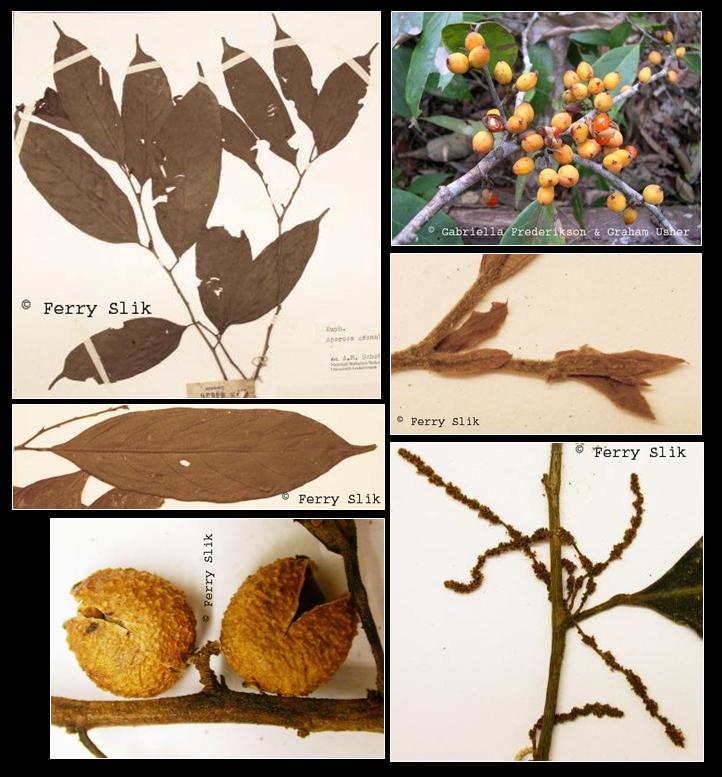Aporosa granularis Airy Shaw, Kew Bull. 29 (1974)
Latin for 'knobbled'.Synonyms
Aporosa microstachya (Tul.) Mull.Arg.
Diagnostics
Shrub up to 9 m tall and 12 cm dbh. Stipules ca. 7 mm long, curved. Leaves
alternate, simple, penni-veined, glabrous. Flowers ca. 0.3 mm in diameter,
yellowish, placed in racemes. Fruits ca. 8 mm long, yellow-orange-red, dehiscent
capsule, seeds with orange aril.
Description
Shrub or tree, up to 9 m high, up to 12 cm diameter. Bark greyish or light brown, smooth to rugose;
inner bark pale brown. Young branches (pale) brown, (sparsely) tomentose. Stipules narrowly ovate,
slightly oblique, 6-8 by 1.5-2.5 mm, very sparsely sericeous beneath, present in young stages.
Petiole terete, adaxially lowly grooved, 7-12 by 0.5-1 mm, tomentose, glabrescent, lower pulvinus
1-1.5 by c. 1 mm, indistinct, upper pulvinus 2-3 by 1-1.2 mm, rather distinct. Leaves narrowly
elliptic, 6-16 by 1.8-5 cm; base obtuse to attenuate, basal glands absent; margin very lowly
undulate to lowly glandular-crenate, marginal glands few, small, grey, indistinct; apex cuspidate
to caudate; blade thin, smooth, dull to slightly shiny, not brittle, drying (dark) greenish grey
to greenish brown above, greyish brown beneath, only midrib and nerves puberulous above,
glabrescent, sparsely puberulous beneath, midrib and nerves puberulous, glabrescent; dots
irregularly set, fine, blackish, mostly indistinct; disc-like glands absent. Nervation: midrib
slightly prominent above, prominent beneath; nerves 6-8 pairs, flat to slightly sunken above,
prominent beneath, marginal arches distinct, 1-3 mm from the margin; tertiary veins and venation
distinct, laxly reticulate, slightly scalariform, flat above, (slightly) prominent beneath.
Inflorescences axillary or just below the leaves. Staminate inflorescences 1-3 clustered together,
5-9 by 1-1.5 mm, puberulous; peduncle 0.5-1.5 by c. 0.8 mm; bracts broadly triangular,
inconspicuous, 0.3-0.5 mm long, very sparsely puberulous outside, glabrous inside, margin ciliate;
glomerules subglobose, c. 1 by 0.5 mm, indistinct, consisting of 3-5 laxly set flowers, some spaced
at 0.1-0.5 mm at base of rachis, mostly continuous at apex; pedicel minute. Staminate flowers
0.3-0.5 mm long; sepals 4, obovate, connate at base, 0.4-0.6 mm long, sparsely hairy at base only
outside, glabrous inside, margin ciliate; stamens 2, slightly exserted, 0.5-0.7 mm long; anthers
0.1-0.2 mm long; pistillode minute, lumpy. Pistillate inflorescences 1 or 2 clustered together,
2-4 by 0.5-0.8 mm, (sparsely) puberulous; flowers up to 7, mostly densely set at apical part of the
rachis; bracts broadly triangular, 0.3-0.5 mm long, sparsely hairy outside, glabrous inside;
bracteoles ovate, c. 0.3 mm long, sparsely hairy outside, glabrous inside; pedicel absent.
Pistillate flowers 1.5-2 mm long; sepals 4, ovate, patent, 0.7-1 mm long, thin, sparsely hairy
outside, glabrous inside; ovary ellipsoid, 2-locular, 1.5-2 mm long, smooth, sparsely sericeous at
base, glabrescent; stigmas sessile, elongated, flattened to the sides of the ovary, apically bifid
to near base, straight, 1-2 mm long, lowly papillate to laciniate above, glabrous, smooth beneath,
glabrous, style remnant absent. Infructescences 3-5 by 0.5-1 mm, sparsely puberulous; fruiting
pedicel absent. Fruits ellipsoid, not stiped, not beaked, 7-9 by 6-8 mm, granular, drying (dark)
brownish, very sparsely hairy, glabrescent; pericarp 0.3-0.8 mm thick, not fleshy; septae and
column glabrous. Seeds 1, half-terete, ellipsoid, 6-7 by 4-5 by 2-3 mm. [from Flora Malesiana:
http://www.nationaalherbarium.nl/Euphorbs/specA/AporosaT.htm]
Ecology
Primary, disturbed, old secondary mixed dipterocarp lowland forest, peat swamp, kerangas; on
undulating country, steep or gentle slopes, and along river banks. Soil: sandstone or sandy (clay),
yellow, rich. Altitude: 50-700 m.
Distribution
Borneo.
Local names
Borneo Ganjii, Janggau, Kayu massam, Kayu matalio.
